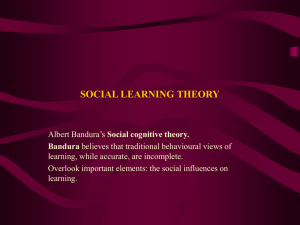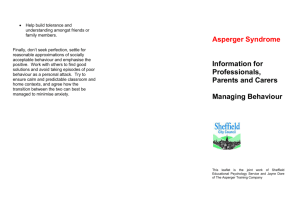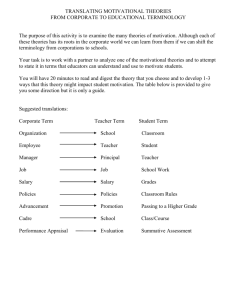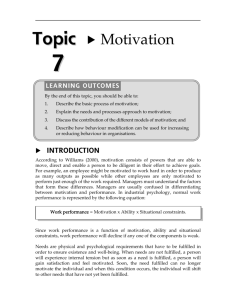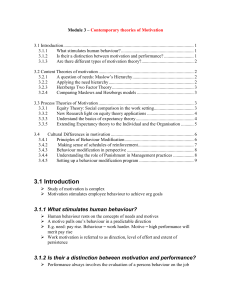Motivation
advertisement
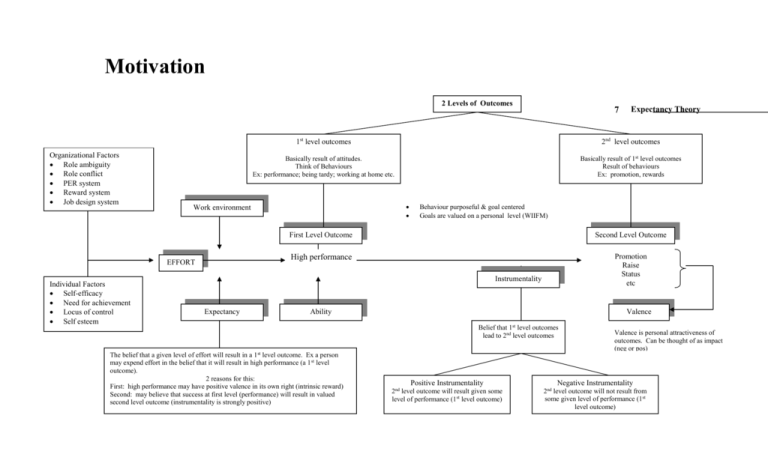
Motivation 2 Levels of Outcomes Organizational Factors Role ambiguity Role conflict PER system Reward system Job design system Individual Factors Self-efficacy Need for achievement Locus of control Self esteem 2nd level outcomes Basically result of attitudes. Think of Behaviours Ex: performance; being tardy; working at home etc. Basically result of 1st level outcomes Result of behaviours Ex: promotion, rewards Behaviour purposeful & goal centered Goals are valued on a personal level (WIIFM) First Level Outcome Second Level Outcome High performance Promotion Raise Status etc Instrumentality Expectancy Expectancy Theory 1st level outcomes Work environment EFFORT 7 Ability The belief that a given level of effort will result in a 1 st level outcome. Ex a person may expend effort in the belief that it will result in high performance (a 1 st level outcome). 2 reasons for this: First: high performance may have positive valence in its own right (intrinsic reward) Second: may believe that success at first level (performance) will result in valued second level outcome (instrumentality is strongly positive) Valence Belief that 1st level outcomes lead to 2nd level outcomes Valence is personal attractiveness of outcomes. Can be thought of as impact (neg or pos) Positive Instrumentality Negative Instrumentality 2nd level outcome will result given some level of performance (1st level outcome) 2nd level outcome will not result from some given level of performance (1st level outcome) Process Theories of Motivation How is behaviour stimulated? Ability Equity Theory My rewards My effort compared to P = ability X motivation Work Attitudes His rewards His effort Benevolent – comfortable with negative inequity Equity sensitives – prefer equity Entitled – comfortable with positive inequity 5 Personality Performance Task Difficulty Always involves evaluation Job Resources 6 Motivation Content Theories of Motivation 2 What specific needs cause motivation? Based on concepts of needs and motives. Only one component of performance. Maslow’s Hierarchy Self Actualization Esteem*** Belongingness** Safety Physiological Herzberg’s Two-Factor Theory 4 3 ** Marks the beginning of higher level needs that are infinite. They can never be fully satisfied. ***Self-efficacy, the ‘can do’ attitude, confidence to achieve high level of performance. Hygienes –maintenance factors Motivators – intrinsic factors Unmet needs are more motivating than needs that are satisfied, since motivation and needs satisfaction are anticipatory in nature. 1 3 Elements Direction – behaviours adopted to do task Both must be present in order to have high job satisfaction. Hygienes necessary as a minimum Level of effort – effort employees do behaviour Extent of persistance – in face of adversity *Low motivation does not always translate into low performance 8 Behaviour Modification 11 Schedules of Reinforcement Based on work of Skinner Belief that behavior is a function of consequences Partial Operant conditioning - reinforcement which modifies behaviour through its consequences Positive reinforcement (Pleasant consequence) Interval Schedule Strengthens behaviour 10 Continuous Negative reinforcement (removing negative consequence) Avoidance learning Ratio Schedule Behavioural Shaping - Closer & closer approximations to desired behaviour Contingencies of Reinforcement Goal Extinction (Pleasant consequence removed) Behaviour is not fed Weakens behaviour Punishment (Unpleasant consequence applied) Fixed Variable Linked to a given number of behaviours (piece rate) Linked to an average number of behaviours Fixed Variable Linked to a set amount of time Linked to an average amount of time 9 Cultural Differences (Motivation) 12 Stretching the ratio/interval Maslow Herzberg Expectancy Cultural Implications of BM Different Cultures = Different Outcomes Why? North Americans rate self actualization as high, the Japanese and Greeks rate security as high (Maslow). New Zealand perceives supervision and peer relations as motivators, whereas we consider them to be hygienes (Herzberg). Expectancy theory is based on individual not collective efforts and perceptions, we see individual effort resulting in performance and reward, Muslims believe performance and results are determined by God BM is an environmental theory of motivation. It de-emphasizes the role of the individual and increases the role of the environment. Rather than having within us what motivates us, we look to the environment - we learn from our experiences in our environment what to do to attain rewards. Therefore BM believes that ego needs for example, have little to do with motivation. Ex: Fixed interval then once goal is achieved, shift to a three day average using a variable interval schedule. After several months average was increased to five days. The purpose is to keep employees from taking rewards for granted. Not good for financial rewards since increases distrust of management. 13 Setting up a BM Program 14 Use of Punishment Define the job Job analysis to ensure understanding of responsibilities - job descriptions Pros Set Standards Complete a Gap analysis Determine the Intervention Define performance behaviours and set performance goals Conduct a baseline audit of present performance and plan where performance should be It is natural (Mother nature does it all the time) Applies positive stress, (deadlines etc) No logical alternative (criminal activity) It can be very effective Select powerful and abundant re-inforcers to reward excellent performance (punishment also considered) Use continual reinforcement to encourage new behaviours (praise and recognition) Cons Practice behavioural shaping manage the program and use coaching and teamwork Modify/reinforce Evaluate Add new positive re-inforcers which employees value to establish desired behaviour Suppresses does not eliminate (behaviour will return if punisher is removed) Stretch the ratio/interval to move employees to a sustained level of performance Employees become anxious Evaluate the program, id and measure target goals (reduced cost, increased productivity, attendance etc) Hard to determine if punishment has actually taken place (may be relative to persons point of view) Employers must closely monitor employee performance 1234567891011121314- Elements of employee motivation Distinguish motivation from performance Maslow's hierarchy of needs Difference between hygienes and motivators Difference between content and process theories of motivation Connection between personality and and employees patterns of social comparisons of work outcomes Major components of expectancy theory and how they relate to organizational processes Develop organizational examples of how behaviour modification works Differences in motivational patterns across cultures Contingency of reinforcement and how to apply the concept Differences between various schedules of reinforcement Why managers should stretch the ratio/interval Steps in setting up a behaviour modification program Identify the pros and cons of using punishment in the workplace Application Rapid Intense Equitable Focused Private Informative Not followed by rewards




